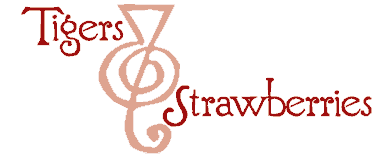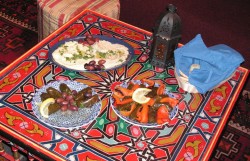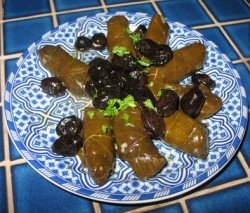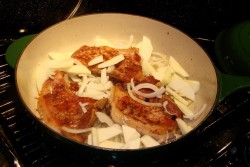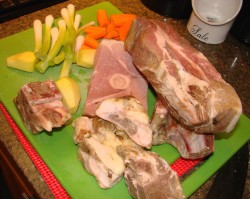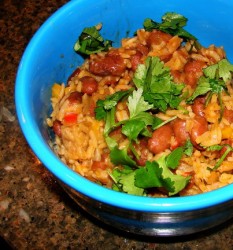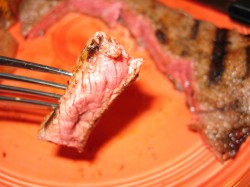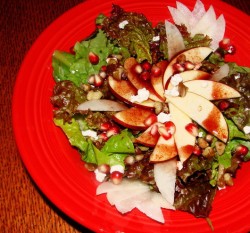Back In A Restaurant Kitchen–At Last!
This is just a quick, jubilant post.
After years of being out of restaurant kitchens, I am going back in–and I am thrilled about it.
I am going to be cooking about twenty hours a week at Restaurant Salaam here in Athens. (For longtime readers, you might remember Salaam as the place where we had our unusual baby shower with the henna belly blessing and the amazing bellydancer, Eli.) It is very exciting, because I had planned on talking to the owner and chef, Hilary, about working with her a few nights a week, just because I needed to get out of the house and wanted to go back to restaurant work. Zak had been reminding me, and then I caught the cold, and then Kat caught it and everything went jumbled–I personally think it is not good form to go asking for a job when coughing like an emphysema patient.
But tonight, when we went in to eat, there was a tiny sign on the door that said, “Dependable kitchen help needed.”
Hilary came to seat us, and I asked about the job, and she said, “Who are you thinking about?”
When I said, “Me,” she didn’t even blink and answered without hesitation, “You’re hired.”
That was the easiest job interview I have ever had. (This blog was my resume, I think–Hilary has been an avid reader for a while now, as she is another super-creative foodie. )
So, after we ate, Hilary took me around, showed me the tiny, but efficiently laid out kitchen, and introduced me to all of her staff.
I can’t tell you all how excited I am. She even wants me to come up with dinner specials!
I start on Wednesday.
I can’t wait!
Pork: The Little White Lie
I just want to clear something up, right here and right now.
Contrary to what the National Pork Board has been saying since 1987, pork is not a white meat.
It is red meat.
End of story.
Well, okay, it isn’t the end of the story, although it should be.
However, 9 out of 10 Americans, because of the pervasiveness of “The Other White Meat” advertising campaign, believe that pork is a white meat.
However, even if pork cooks up to be pale, nutritionally speaking, isn’t a white meat–it is a red meat. Its fat content, protein content, and calorie content is much more akin to beef than to chicken. In addition, when scientists study the effects of red meat on human digestion and the development of colon cancer, pork is one of the meats included in the test protocol.
How is a meat classified as being red or white? It is determined by the amount of myoglobin–a protein-based oxygen-carrying pigment–present in the muscle tissue. Beef, lamb, goat, pork and veal are all considered, by virtue of their myoglobin, content, to be red meats, even though both veal and pork are considerably paler in color both when raw and cooked than beef, lamb and goat.
By some classifications, all mammal meats are considered red meat, although by some gastronimic definitions, rabbit, pork and veal are all considered, along with chicken, turkey and fish as white meats.
(Are you confused yet? Probably–which is why the National Pork Board’s ad campaign worked so darned well.)
How did “The Other White Meat” campaign come about in the first place?
According to The Other White Meat website, in 1987 consumer demand for pork was declining while chicken was precipitously rising in popularity. This was due, in large part, to current nutritional findings about dietary fat and human disease.
After researching the decline of red meat consumption and the rise in white meat consumption, folks at the National Pork Board found that white meat was perceived as being lower in overall fat, saturated fat and calories than red meat, and so was seen as more desirable to the American consumer. So, despite the fact that pork, a red meat, is higher in fat, saturated fat and calories than chicken, a white meat, the pork folks decided to just change the American consumers’ perceptions about it, and just call it, “The Other White Meat.”
In addition, pig breeders developed pigs that carried less body fat in their muscle tissues, which did lower the fat content and calories of pork significantly in the past few decades, which has led to much pork sold in grocery stores in the US being injected with saline so that it will not dry out when cooked. (This is called “value added” marketing, by the way, and not coincidentally, when you add water to a meat product, your customer ends up paying partly for water, not meat. “Value-added” indeed.)
But, even when comparing today’s leaner pork with chicken, nutritionists who are not in the employ of The National Pork Board, generally do not find it at all comparable to chicken. Yes, pork has fewer calories and less fat than beef, but it still has 1/3 more fat and calories than skinless chicken. That is a fact.
Bonnie Liebman and Jayne Hurley, writing for Center for Science in the Public Interests, November 1995 issue of Nutrition Action Healthletter, state:
With pork, you don’t just have to watch out for the fat in the meat. The advertising can get you, too. Take “The Other White Meat” ads that are run by the National Pork Producers Council. They’re bunk. Pork may be light in color, but it’s not as lean as chicken or turkey. According to the USDA, a typical cut of trimmed pork is one-third fattier than skinless chicken and twice as fatty as skinless turkey. And the pork would have been even worse had the USDA included spare ribs in its “typical” pork numbers.
Yes, if you read that carefully, you can see that some cuts of even today’s “leaner” pork, are fattier than some cuts of beef, which is usually held up as the fattiest of meats. Another bit from the same article asks and answers, “Which has more saturated fat: trimmed pork tenderloin or trimmed Select grade beef round steak? (Pork) tenderloin.”
You can also infer from the above quotes that the USDA also considers pork red meat, not white meat.
That inference is correct.
In “Safety of Fresh Pork…from Farm to Table”, a USDA fact sheet, consumers are told that the USDA classifies pork as a red meat for these reasons:
Oxygen is delivered to muscles by the red cells in the blood. One of the proteins in meat, myoglobin, holds the oxygen in the muscle. The amount of myoglobin in animal muscles determines the color of meat. Pork is classified a “red” meat because it contains more myoglobin than chicken or fish. When fresh pork is cooked, it becomes lighter in color, but it is still a red meat. Pork is classed as “livestock” along with veal, lamb and beef. All livestock are considered “red meat.”
So, if the USDA classifies pork as a red meat, and it really isn’t nutritionally comparable to chicken, a white meat, then why is The National Pork Board allowed to tell us that it is “The Other White Meat?”
Remember, way up at the top when I noted that even though pork is technically, if you go by the myoglobin content, and the nutritional data, a red meat, gastronomically, it (along with veal, rabbit and chicken) is considered white meat because of their cooked color? That is most likely the legal loophole that the public relations geniuses who came up with the campaign used in order to sell Americans on “The Other White Meat” lie.
Because, if gastrnomical definitions are so confused on the point, and some sources (even if they are not scientific, nutritional or governmental sources) define pork as a white meat, then no one is strictly lying if they call pork a white meat. It isn’t a lie–it is a misdirection. A “white lie,” if you will.
I guess you could call the whole issue The National Pork Board’s “Little White Lie” that brought them a whole big pot of money.
Peasant Food is Good Food: Beans and Rice
There is a song by Spearhead that I love, and it goes (in part) like this:
“….The way to my heart/ is with a garlic clove
it smells hella sexy/ when it’s on the kitchen stove
(chorus)
Red beans and rice, red beans and rice, red beans and rice,
make everything nice
red beans and rice, red beans and rice, red beans and rice
I could eat a plate twice. So nice. So nice. So nice.
Most people on the planet/ eat beans and rice
some can’t afford beef or they think cows are nice….”
You can see why I love “Red Beans and Rice.” That’s the name of the song, if you hadn’t figured it out yet. I swear if I ever get a cooking show (ha!) of my own, I’d want this song as my theme music. I just love it.
Just like I love the traditional New Orleans Cajun/Creole Monday supper dish, red beans and rice.
Why was it traditionally made on Mondays? Because Monday was washing day, and Mammas all over South Louisiana could put a pot of beans to simmer all day long on the stove where it could tend itself while she tended to the laundry.
I like red beans and rice on Mondays, Tuesdays…any old day will do, really.
Now, the real, traditional way to make red beans and rice is to saute the Holy Trinity in your pot, (you know that would be bell pepper, onion and celery, right, cher?), along with some added herbs and garlic, and then maybe add some tasso and andouille sausage. (Or, you can throw in the bone from Sunday’s ham–that is wholly traditional and appropriate, too.) Then you add water or stock or broth, and your dried little red beans and then bring them to a boil, turn down your heat and simmer them all day long. You only need to check on them now and again, and they make the house smell wonderful as they cook.
At dinner time, all you need to do is make a pot of fluffy white rice, and you serve the beans, along with a ladleful of the savory juices over it and you have a delicious meal. I like to add a green salad or a mess of lightly sauteed greens alongside, just to make it a balanced meal, but I have to admit to dining more than once on just a bowl of beans and rice for my supper.
It is nutritious, filling and inexpensive to make. It’s peasant food.
And I am here to tell you that peasant food is good food.
In truth, I tend to prefer to buck tradition with my beans and rice, and cook it without much in the way of meat; usually, the only meat I use is a bit of smoked ham hock to give the beans a smoky earthiness when I cook them. Or a bit of ham bone. (And when we had dogs, they would love the hock or bone after dinner was cooked.) But I really like the beans to be themselves without added sausage or bits of the ham-like tasso or even ham. I guess it is because I just love beans so much that I don’t want them to be all muddied up with extra added meat.
No, it isn’t a completely vegetarian dish this way, but I am omnivore, after all. If you want to make a completely vegetarian/vegan dish, use smoked Spanish paprika to give a similar flavor. Or, if you do not eat pork or red meat, you could use the paprika trick or use a smoked turkey wing. Smoked turkey wings make great pots of beans that are lower in fat and quite high in flavor.
I also have to admit here to not necessarily always using the traditional small red beans that folks in Louisiana use. This is because I cannot always get my hands on them here in Ohio. (When I can get them, though, I always buy them up in bulk.) The usual substitution is red kidney beans, but you know, I don’t really like the flavor of them, and I don’t like the tough skins they have. So, instead, I use Italian style Cranberry beans. pictured here. They cook up a pale reddish brown, not quite as red as real red beans, and they have a sweet flavor and a silky smooth texture that is so much nicer than kidney beans. They are really delicious–just as tasty as their spotted, speckled and dappled coats are.
I also have to warn you–I don’t really make my beans and rice traditionally, either. First of all, I don’t let my beans simmer all day–I cook them in the pressure cooker. And secondly, I don’t just serve them with their broth over plain white rice–I make a sort of rice pilaf using the cooking liquid from the beans to cook the rice in, after I have sauteed the rice with onions, pepper, celery, garlic and herbs to give it a nice flavor. I cook it in the rice cooker, but it could just as easily be cooked on top of the stove the way that other pilafs are cooked.
Then, when the rice is done, I mix it with the beans and then sprinkle it with either roughly chopped fresh flat leaf parsley or cilantro. (Cilantro is so not traditional, but it tastes good, so there.)
Really, it is easier to just serve the beans over the rice, so in my method, I give instructions to make it both ways. I just like my way better, even if a lot of Creole folks would roll their eyes at me and think I was crazy.
But still–when it comes to taste–a little extra work is almost always worth it to me.
Almost Vegetarian Red Beans and Rice
Ingredients:
2 large onions, finely diced
2 stalks celery, strings removed and finely diced
4 bell peppers (I prefer red, yellow, orange or brown ones to green) finely diced
2-4 fresh red cayenne or serrano chilies
1 head garlic, minced
2 tablespoons olive oil
1 bay leaf
1 tablespoon thyme leaves, fresh or dried
1/2 teaspoon powdered dried rosemary
ground cayenne pepper to taste
1 teaspoon smoked Spanish paprika
black pepper to taste
1 ham hock (or a tablespoon smoked Spanish paprika, or a smoked turkey wing)
1 quart vegetable or chicken stock or broth
1 pound dried small red beans, cranberry beans or kidney beans–whatever you prefer–picked over, rinsed and drained
1 cup water
salt to taste
3 tablespoons olive oil
2 1/2 teaspoons fresh or dried thyme
pinch dried rosemary
ground cayenne to taste
1 teaspoon smoked Spanish paprika
3 cups jasmine rice
3 3/8 cup of the bean cooking liquid
1 cup flat leaf parsley or cilantro leaves, roughly chopped
Method:
If you are planning on using my rice pilaf method of cooking the rice, split your fresh aromatic vegetable ingredients into two equal parts, and set one of those halves aside to be used in cooking the rice. If you are just going to serve over plain white rice, then put all of the aromatics in with the beans.
Heat the first measure of olive oil in a heavy-bottomed dutch oven or pressure cooker over medium high heat. Add half (or all) of the aromatics, and cook, stirring, until the onions turn translucent gold and everything else is soft and fragrant. Add the first list of spices and herbs, and continue cooking for one minute. (If you were going to use ham, tasso or sausages, now would be the time to put them in so they can brown and flavor the oil with their fat.)
Add the ham hock, the broth or stock, the beans and the water, and bring to a boil over high heat. If you are cooking in a regular pan, cover, turn the heat down to low, and cook for about four hours, or until the beans are completely done. Stir now and then and make sure that the water level stays about an inch above the beans, adding water or broth as needed.
If you are using a pressure cooker, bring to a boil, put the lid on the cooker, bring to full pressure, and turn heat down and cook over high pressure until done–small red beans take about a half hour, cranberry beans, thirty-five minutes and kidney beans forty-five to fifty minutes. Quick release pressure and make certain the beans are fully cooked.
When beans are done, ladle out the 3 3/8 cups of beans cooking liquid for the rice, if you are making it pilaf style–otherwise, leave it alone, and you are ready to let the good times roll–just salt the beans and liquid to taste and serve over plain white rice.
After the bean liquid is measured out, keep the beans warm.
In a heavy-bottomed skillet (if you are using a rice cooker) or dutch oven, (if you are cooking on the stove) heat the second measure of olive oil over medium high heat. Add the other half of the vegetables and cook as before–until the onion is translucent gold and everything else is soft and fragrant. Add the herbs, and cook one more minute, then add the rice and cook, stirring until every grain is coated with the oil.
If you are using a rice cooker, dump the contents of the pan into the cooker bowl, and pour in the bean liquid. Close the cooker and turn it on, Wait until it is done.
If you are cooking on the stove, pour the bean juice into the dutch oven, and bring to a boil. Turn the heat down to low, tighly cover the pot and cook for twenty minutes. Remove from heat and let sit for ten minutes before opening up the pot.
After the rice is done, mix the rice with the beans and the remaining small amount of cooking liquid and garnish with the chopped fresh herbs.
This makes about six good sized servings.
PETA Says Meat Eating Is The Biggest Cause of Global Warming
Of course, meat eating isn’t the largest producer of greenhouse gases, (burning fossil fuels for electricity wins that crown) but it sure makes a good headline, doesn’t it?
Last month, according to an article in Salon by Liz Galst entitled, “Earth to PETA,” PETA (People for the Ethical Treatment of Animals) members tried to bring attention to their assertion that global warming was caused primarily by meat eating in Washington DC by not only donning chicken costumes and passing out fliers with the ever so alienating message, “Think you can be a meat-eating environmentalist?” Think again!,” but also by draping a banner with their incorrect assertions across a gas-guzzling Humvee and driving it around downtown traffic.
This is an example of why I really dislike PETA as an organization, even if I agree with some of their goals. (If you count the reduction of animal suffering in the world as one of their goals.)
My first objection to their tactics in this instance is that, once again, PETA is engaging in obfuscation of facts, or in this case, outright lying, to present their viewpoint, which is that meat-eating is immoral and unethical. In this case, they are trying to guilt the environmentally conscious among us into not eating meat, not because it is immoral or unethical, but because it is supposedly the biggest cause of global warming.
I agree that confined animal feeding operations (henceforth to be known as CAFOs for short) degrade the environment horribly and not only contribute to some extent to global warming, but even worse, create groundwater contamination and adversely affect air quality, but I don’t feel the need to lie about it in order to get my point across. I also agree that the conditions under which animals are raised in CAFOs is inhumane and unhealthy, not only to the animals but to the people who work with them, and ultimately, to the people who eat those animals. That is why I take great care to avoid all products–meat, poultry, eggs and dairy–from CAFOs.
But again, I see no reason to embellish the facts about CAFOs by adding untruths to my statements in support of my argument that they promote unsustainable, unethical forms of animal husbandry. The truths about CAFOs are damning in and of themselves.
But back to PETA.
If eating animals is immoral or unethical, what is lying? Perfectly okay?
What kind of morality or system of ethics does lying promote?
And what the hell is up with driving a Hummer, one of the most fuel inefficient vehicles around, with PETA’s (incorrect) message that meat eating is the main cause of global warming around and around in DC traffic? Is this meant to be ironic? Is it meant to show that PETA vegans can drive whatever they want because they are not eating meat? Is it that PETA’s publicity stunt coordinators really are that clueless?
Or, is it just a plain old ugly show of the sort of hypocritical behavior that keeps me from openly supporting PETA even when I agree with them in principle? (Because, the truth is, I agree with them that animals should be treated with respect, dignity and decency. Of course, that means to them that they should never be eaten–to me, it means that if they are eaten, they should be treated well while they are alive, killed quickly and humanely, and then eaten.) Putting your lie about global warming on a Hummer and driving it through traffic tells me, and probably a lot of other people, that PETA doesn’t really give a damned about global warming. They just want people to stop eating meat, by whatever means necessary.
My feeling about this latest chapter of PETA’s ever-devolving attention-getting antics is this: if you are going to claim moral superiority in your positions, then you had best act in a moral fashion. That means that you shouldn’t lie. Most people think that lying is not a particularly moral or ethical way to communicate with the world. Lying to people does not enhance one’s standing in society, nor does it make people trust one. It is a thing.
Not only is lying a problem, but trying to make a point about global warming while driving around a vehicle that very much contributes to the problem of global warming is just plain stupid. People are going to laugh at you at best, or scoff and ignore you, or at worst, completely discount everything that you say now and in the future when it comes to environmental concerns. Doing stuff like that discredits PETA and their message. (Which, since, in this case, their message is completely bogus–maybe isn’t such a bad thing.)
Now that I have gotten all of that off of my chest, I want you to go read the Salon article–Galst makes some good points, though I think that quite a bit of her data is off.
The crux of her argument is that while PETA is incorrect in its exact statement, the sentiment is correct: eating CAFO meat is contributing to global warming and environmental decline. So, we should eat less of it. Galst’s article specifically states that chicken eating creates less of a carbon imprint than beef eating or pork eating, so if we are going to eat meat, we should eat chicken. If you look at her argument from a completely environmental standpoint, she is mostly correct, although I quibble with her when it comes to grazing animals on non-arable land. (That means that grazers and browsers, like cattle, bison, goats, sheep and hogs can efficiently turn rocky, scrubby grasslands, hills and marginal lands which are completely unsuitable for crop production into milk and meat that humans can consume by eating that which we cannot eat: grass.)
Of course, as the commentors on the article pointed out, both the author and PETA seem to have ignored the root cause of global warming which is not fossil fuels, industrialization or meat eating, but human overpopulation. We simply have too many people using too many resources in an unsustainable fashion for the earth to support us. That is a fact. We produce enough food to feed everyone now (of course, because of political reasons not everyone gets the food we produce for them–starvation, at this point is largely caused by human greed and corruption, not by lack of resources), but if population growth continues at present rates, we will no longer be able to support everyone in fifty or a hundred years.
Population is the reason we have so much fossil fuel dependent industry, transportation and agricultural systems–all of which contribute mightily to global warming.
What do I propose to stop this rampant population growth? Education of women, support of birth control and in extreme cases, governmental family size caps. (The latter I think should only be used in times of extreme need, as the current experiment in governmental population control in China has resulted in a lot of problems and civil rights abuses.) However, it has been shown throughout the world, that in countries where women are educated, and given economic opportunities, and access to birth control, not only does the standard of living for women and children in that country rise, the per capita birthrate drops.
So, what do I suggest that we do as individuals to help slow down global warming?
Number one, walk (or bike) more and drive less. Or, when you can, use public transportation. And if you drive, get as fuel-efficient a car as you can afford and keep it in good working order.
Two, eat las much ocal food that is sustainably produced as you can. Eat less meat, and more vegetables, and what meat you eat, try to get from non-CAFO sources. Vote with your shopping cart for sustainable agricultural practices as much as you possibly can, as often as you possibly can. Try not to eat fast food, if you can. Go vegan if you like, but if you do, don’t be so insufferable as to believe and spout to all the world that it is the only way a person can be a true environmentalist or the only diet that an ethical human can eat in order to save the planet. All you will do with that is make yourself and other vegans look like twits. And I know for a fact that most vegans are very nice, ethical people who do not deserve the twitty reputation that has been slapped upon them by PETA’s (and an obnoxious and vocal vegan minority’s) antics.
Three: try not to have a bazillion babies. Support adoption programs, including open adoption in the US. Support birth control use and education both here and abroad. Support the education of women here and abroad. Support workers rights so that folks can support the children they do have.
Four: try to grow some of your own food. Support community gardening programs. Support the harvest of rainwater, and community composting efforts to keep biomass out of the landfills where all it will do is contribute to CO2 emissions. Support green fuels, green electricity (solar and wind power, for example) and recycle. Use compact fluorescent light bulbs, (they are really nice, not like those old flickery tubes they lit up our schools with back in the day–we use them here and I love them) and don’t use your air conditioners or heat pumps as much.
Oh, and don’t give money to PETA. They’ll probably spend it on a Hummer and some chicken suits.
Green Salad with Chevre, Black Walnuts, Apples and Pomegranate Vinaigrette
This very picturesque salad was a collaborative effort between Morganna and I, and it typifies all that I believe a salad should be–a beautiful combination of flavors, color, textures and aromas which beguile the senses while retaining an essential simplicity of presentation which is still lyrically aesthetic.
I made the dressing, and came up with the concept for the salad.
Morganna was responsible for the execution of the salad; she did the slicing, and the plating, and decided on the proportions of the ingredients to be used. All I said to her as she worked on it was that the salad had to be “pretty.”
Grumbling the entire time about how she could never work as a garde manger–the person who does cold (and sometimes hot) appetizers, cold plates and salads–because it requires too much finicky work, Morganna put together a gorgeous salad with excellent presentation.
The main component is the two-toned butterhead and leaf lettuces which make the underpinnings of the salad; the other focal ingredients were locally grown tart Johnathan apples and icy-crisp, spicy Asian pears.
To add crunch and color, I included pomegranate seeds and black walnuts, which are an Appalachian native tree nut. They have a musky, dark flavor that is sweet, yet redolent of the scents of fallen leaves and damp woodlands. To me, black walnuts are the essence of autumn distilled into a very small, buttery package.
Flecks of snow white tangy goat cheese rounded out the salad, giving a touch of richness echoed by the nuts, and a bit of smoothness found in both the lettuce and the apple. Its soft, yielding texture and dairy fragrance, however, were its own.
The dressing was simple–a vinaigrette with pomegranate juice concentrate instead of vinegar, a touch of honey, a pinch of salt, and a nice dollup of really good, rich olive oil. (If I had walnut oil in the house, that is what I would have used, but I was out.)
The pomegranate juice concentrate, pictured here, could be replaced with a similar, more traditional product, pomegranate molasses, but again, I had used the last of my stash in a salad dressing a few weeks prior to this salad. So–necessity being the mother of invention, I used this concentrate, meant to be added to water to make a pomegranate juice drink, was perfect. I had found it a while back at my grocery store, and had used it in making a sauce for my pomegranate cheesecake–its ruby color and tart, syrupy consistency were a perfect foil to the rich tang of the cheesecake and the crunchy, sour nuggets of fresh pomegranate seeds.
The dressing is simplicity itself to whip up–I just put the ingredients together into a bottle and shook it up well, then let it sit at room temperature until serving time so that the flavors could meld together perfectly.
The collaboration worked–the salad captivated the senses–balanced perfectly between sweet and sour flavors, pale and brilliant colors, crisp, soft, yielding and buttery textures, and strong and delicate fragrances, it was also a delight to the eyes.
Morganna, her protestations to the contrary, would make a very good garde manger, if she set her mind to it.
Green Salad with Chevre, Black Walnuts, Apples and Pomegranate Vinaigrette
Ingredients:
1/4 cup pomegranate juice concentrate or pomegranate molasses
3/4 cup very good extra virgin olive oil
honey to taste
salt to taste
8 ounces mixed leaf and butterhead lettuces, washed, dried and torn into bite-sized pieces
1 Jonathan, or other tart apple, washed well and sliced thinly
1 Asian pear, peeled and cut into paper thin slices
1 pomegranate, seeds removed from the peel and pith
1 ounce black walnuts, roughly chopped
1 ounce tangy goat cheese, crumbled into bits
Method:
To make the dressing, put first two ingredients into a bottle or jar, and close tightly. Shake like mad. Taste and add honey and salt to your liking. The flavor should be a balance between sweet and sour with just a tiny hint of salt to balance it. The oil should just hold it all together with a hint of buttery richness.
Divide lettuces between four individual salad bowls or plates.
Arrange apple and Asian pear slices in a decorative pattern over the lettuces. Sprinkle 1/2 the pomegranate seeds (reserve the rest of the seeds for another use or snack on them while you are fixing dinner–we chose the latter course of action) and the walnuts and goat cheese over the salad.
Just before serving, shake salad dressing again to emulsify it and drizzle over the salads in a spiral pattern.
Powered by WordPress. Graphics by Zak Kramer.
Design update by Daniel Trout.
Entries and comments feeds.
